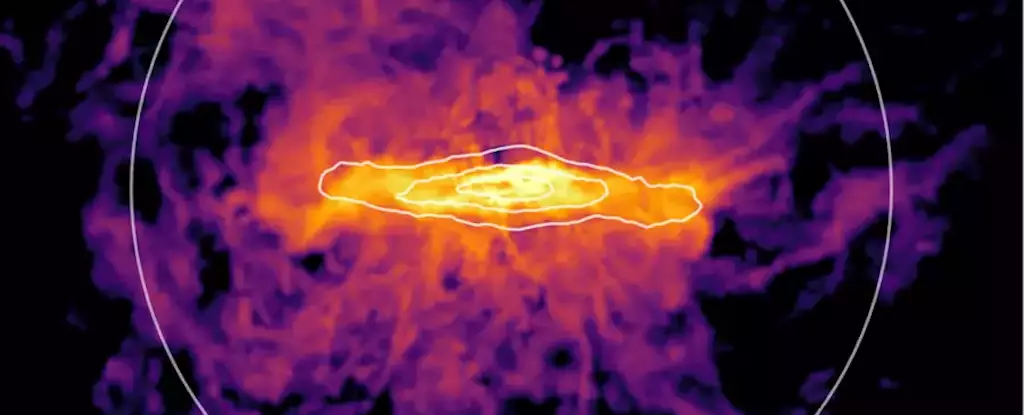The exploration of the cosmos often leads to profound revelations about our origin as a species. Carl Sagan’s resonant proclamation, “We are made of star-stuff,” encapsulates this idea, suggesting a deep kinship between humanity and the universe. Recent findings from the Hubble Space Telescope offer a fascinating twist to this narrative; they unveil the astonishing journey of carbon—a critical building block of life—that may have traveled hundreds of thousands of light-years before becoming part of our bodies. This article delves into the implications of this discovery, reshaping our understanding of the material that constitutes our very essence.
The Stellar Lifecycle and Element Formation
To comprehend the journey of carbon, it is essential to grasp how elements heavier than helium are formed within the hearts of stars. These massive celestial bodies create heavier elements through a process called nuclear fusion. During their explosive end-of-life events—supernovae—stars discharge these newly forged elements back into the surrounding cosmos. Once expelled, the remnants don’t simply fade into obscurity; they become integral in the formation of new stars, planets, and ultimately life itself.
Recent research has revealed a remarkable detour taken by some of these elements, particularly carbon. Instead of going directly from stars to planets, carbon often finds itself adrift in a vast cloud of gas known as the circumgalactic medium (CGM). This discovery challenges the traditional path we believed elements followed and highlights the CGM as a pivotal player in cosmic evolution.
Scientists from the University of Washington, using Hubble’s Cosmic Origins Spectrograph, studied the CGM surrounding 11 star-forming galaxies. Their findings indicated that carbon could be detected as far as 391,000 light-years from its host galaxy, a distance that significantly surpasses the Milky Way’s diameter of approximately 100,000 light-years. This data paints a vivid picture of carbon’s extensive journey through space, reminiscent of a traveler exploring distant lands before returning home.
Lead author Samantha Garza likened the circumgalactic medium to a sprawling train station where materials continuously cycle in and out. In this scenario, supernovae act as the engines driving this cosmic train, expelling heavy elements into the CGM, where they may linger for eons before being recycled back into new stellar formations. This dynamic system raises intriguing questions about the availability of carbon in galaxies and its influence on star formation.
One of the most fascinating aspects of this research is the method used to identify carbon in the distant CGM. Each element interacts with light in unique ways, absorbing specific wavelengths. By examining the light from nine distant quasars, researchers were able to detect carbon’s spectral fingerprints within the CGMs of various galaxies. This innovative approach not only confirmed the presence of carbon but also marked the first observation of cooler elements participating in this recycling process, a significant leap in understanding the chemical dynamics of galaxies.
Previous studies had already established that heavier elements like oxygen were cycling through the CGM, but the inclusion of carbon shows a broader, more complex ecosystem of elemental interaction. The implications are vast. We now understand that the CGM functions as a reservoir, both for carbon and oxygen, poised to supply these critical elements back into star-forming galaxies.
The variability in carbon and oxygen cycling suggests an exhilarating relationship between star formation and the characteristics of the circumgalactic medium. Active galaxies, which are incessantly forming new stars, demonstrate a higher abundance of these materials compared to their more passive counterparts. This observation aligns with previous data indicating that star-forming galaxies have (and use) more oxygen in the CGM.
This cycle is significant for understanding not just our celestial neighbors but also our Milky Way. As our galaxy continues its star formation, it’s likely that some of the carbon and oxygen found in our immediate vicinity has embarked on journeys through the cosmos, contributing to the rich tapestry of life on Earth.
The revelations regarding carbon’s interstellar travels underline the profound interconnectedness of the universe. Every atom in our bodies is tied to an incredible narrative of creation, destruction, and rebirth. By studying the dynamics of the circumgalactic medium, astronomers gain insight into the driving forces behind galaxy formation, star birth, and potentially catastrophic cosmic events such as galactic mergers.
In this light, Sagan’s words echo with renewed meaning. The ‘star-stuff’ within us did not settle into a simple existence; it journeyed through the cosmos, mixing with the fabric of the universe before finding its way back home—culminating in the very beings we are today. We are not merely products of our planet but rather the culmination of an epic saga woven through the stars.

